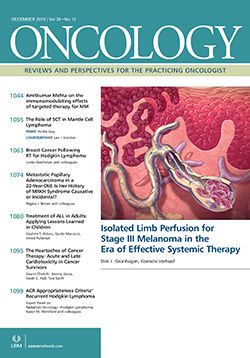Amitkumar Mehta on the Immunomodulating Effects of Targeted Therapy for Multiple Myeloma
In this interview we discuss the mechanisms of daratumumab, how it is currently used for the treatment of multiple myeloma, and how it might be used in the future.
Oncology (Williston Park). 30(12):1044, 1054.

Amitkumar Mehta, MD

1. Can you explain the known mechanism of action of daratumumab, and how it is currently used to treat multiple myeloma?
DR. MEHTA: Daratumumab is an anti-CD38 immunoglobulin (Ig) G1 monoclonal antibody-the first to be approved for the treatment of relapsed/refractory multiple myeloma. About a decade ago, preclinical studies showed that targeting CD38 might be feasible, and last November, two clinical trials showed significant activity of single-agent daratumumab, leading to US Food and Drug Administration approval of the drug. The first trial-GEN501-was a phase I trial, with an expansion phase II trial, and the second was the SIRIUS phase II trial. In both studies, as a single agent, daratumumab showed an overall response rate of approximately 30%, higher than any other previous single-agent proteasome inhibitor or immune-modulator drug. The effect of daratumumab is through three different mechanisms: antibody-dependent cytotoxic activity; complement-dependent cytotoxicity; and antibody-dependent cellular phagocytosis. Apart from that, there is some new immune-directed activity that is worth discussing.
2. You are referring to a study published this year in the journal Blood that showed that daratumumab not only exerted its effects through CD38-expressing cells, but also boosted the number and activity of cytotoxic T cells and helper T cells. Can you describe the study and how it was conducted?
DR. MEHTA: This study by Krejcik et al[1] tells us about the importance of biomarkers in the research setting. Nearly all studies collect biologic samples, including biopsies, so that we have an idea of why the drug works, or in whom the drug works, and whether we have biomarkers that we can relate to the drug. In this study, peripheral blood and bone marrow samples were collected before and after treatment, during the trial, and at the time of progression. The samples were analyzed for different immune factors and assessed for functional activity of the immune cells. The researchers looked at the microenvironment, as well as various T cells and immune cells such as regulatory B cells, myeloid-derived suppressor cells (MDSCs), and also a novel T-regulator cell expressing CD38, and discovered that immune action was being prohibited on these multiple myeloma cells. Daratumumab helped improve the tumor microenvironment by enhancing the immune response, and actually reduced T-regulator cells, MDSCs, and B-regulatory cells at the same time that it helped expand helper and cytotoxic T cells. In addition, there was also an increase of functional activity of these cells, which had more alloreactive functions.
In the current era of immune therapies, such as cytotoxic T-lymphocyte–associated antigen 4, programmed death 1, and programmed death ligand 1 antibodies that have been used across different solid tumors and hematologic malignancies, there has been significant activity of this type of immune mobilization. We know from previous studies that multiple myeloma also has immune dysfunction, including immune evasion through expression of various immune checkpoints, elevated immune receptors and activity, and immune suppression through MDSCs.
3. Based on this work, what further studies or trials would you like to see next on this newly identified activity?
DR. MEHTA: In this setting, we see a similar activity as with immune checkpoint inhibitors, which is immune enhancement. The significance of daratumumab is that it also targets CD38-positive plasma cells. This “dual action”-where the tumor is targeted and there is immune enhancement against the tumor-is a very elegant pro–immune system action against the tumor cells. Therefore, it’s a no-brainer that we should combine checkpoint inhibitors to see if this immune enhancement is stronger toward myeloma cells. Also, with pomalidomide and thalidomide, which are immune-modulating drugs that are the standard or backbone of myeloma treatment, there is the question of whether a combination of these drugs may enhance the immune action against myeloma cells. The most important strategy is to use daratumumab in earlier stages of myeloma, like monoclonal gammopathy of undetermined significance or smoldering myeloma, to see if we can mobilize the immune system in a way that can achieve longer antimyeloma control.
4. Is there potential to use this antibody for other hematologic malignancies or solid tumors?
DR. MEHTA: If daratumumab is mobilizing the immune system in a way that reduces the B- and T-regulatory cells (that inhibit T-cell function) and MDSCs, whether it can act as another immune checkpoint inhibitor and be combined with other antibodies or cytotoxic therapies in various other solid tumors is an open question. I believe we will see these types of studies with daratumumab in the future.
Financial Disclosure:The author has no significant financial interest or other relationship with the manufacturers of any products or providers of any service mentioned in this article.
Reference
1. Krejcik J, Casneuf T, Nijhof IS, et al. Daratumumab depletes CD38+ immune regulatory cells, promotes T-cell expansion, and skews T-cell repertoire in multiple myeloma. Blood. 2016;128:384-94.
